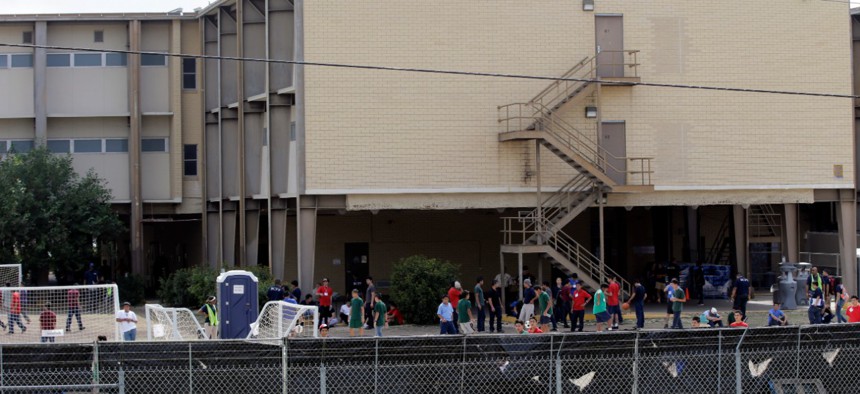
A temporary shelter for unaccompanied minors who have entered the country illegally is seen at Lackland Air Force Base, in San Antonio, June 23, 2014. Eric Gay/AP file photo
Viewpoint: When Children at the Border Got Compassion
The United States has a moral responsibility for unaccompanied children—and took it seriously, at least in 2014.
In the spring of 2014, a sudden surge of unaccompanied children began crossing the southern border from Mexico into the United States. I was the undersecretary of the Air Force at the time, and the Pentagon had been tasked with finding facilities and funds so that the Department of Health and Human Services could shelter children until they were reunited with family. It was my job to review the housing that the Air Force would provide. So, with a few others from the Pentagon, I flew down to Lackland Air Force Base in San Antonio, Texas, to see for myself that these children were being cared for and protected.
It was hard for any of us to understand the trauma the children had already experienced. But we knew that our role—our moral responsibility—was not merely to deal with them, but to care for them. And that is exactly what our country did.
We set up multiple facilities on military bases, and HHS worked with a coalition of organizations to shelter these vulnerable children while we looked for proper guardians. There was an outpouring of local community support, from church groups making food to a nearby school donating artificial turf for a soccer field.
A different set of values is now on display, as a new surge of migrants from Central America is fleeing northward toward the United States. Many are escaping extreme violence, while others are yearning for a better life for themselves and their families. Upon their arrival at the American border, the United States is placing these people—including children—in appalling physical conditions, needlessly turning an immigration challenge into a humanitarian crisis.
The policies currently in effect include stripping kids from their families, holding them in conditions unfit for human health, and prioritizing their incarceration over placing them with family or guardians. Every news cycle brings to light new revelations that tug at our hearts: young children caring for infants; kids covered in food and filth, sleeping on cold floors with the lights always on; officials arguing that “safe and sanitary” doesn’t mean providing soap or toothbrushes, let alone the mental-health services children going through traumatic experiences require.
While immigration is a complex issue, we are entirely capable of both securing our borders and treating migrants humanely. Even in this moment when nearly every debate feels polarized, Americans should all be able to agree at least on the paramount importance of protecting and caring for the children involved.
Back in 2014, the makeshift facility at Lackland Air Force Base was open for four months and cared for more than 3,600 children. There were more than 100 Spanish-speaking case workers whose primary task was connecting kids with family, so that Border Patrol officers weren’t in charge of caring for children—a task they were never trained to do.
Officials arranged for English, math, and art classes—and sports—for migrant children; citing budgetary reasons, the present administration has canceled such vital services. Five years ago, children slept in dormitories with beds and blankets, not on ice-cold floors. And dozens of medical staff and resources were available, from a clinical psychiatrist to a mobile medical unit for contagious children, which kept dangers such as flu and lice from spreading.
I was proud that so many organizations, inside and outside of government, came together so quickly to make a terrible situation for these children somewhat better. But the way migrant children are treated today is reprehensible. It defies the values of this country and shirks our responsibility as both Americans and humans. And history will not treat these choices kindly.
We cannot continue these inhumane policies. To alleviate the suffering of migrants, and especially children, there are obvious steps we should take now:
First, the policy of separating children from their families must end. Journalists and lawyers report that hundreds of children are still being separated from their families—more than 900 since June 2018.
Second, the federal government must upgrade conditions at any facilities where children are being housed. Congress recently set aside more than $4 billion to improve conditions at migrant detention centers. This money should be used to create facilities that are shelters, not jails.
Finally, we must quickly reconnect separated children with family or guardians. This is the only sustainable way to approach this crisis—and the only humane one.
Five years after my visit to Lackland, I vividly remember how dazed and traumatized the children seemed. They had crossed through unfamiliar countries and difficult terrain. Some had fled with aunts and uncles, and some were on their own. Seeing their faces made it all the clearer that their well-being had to be our highest priority.
The same is true today. That means treating children right when they’re in our care and reuniting them with family, who can take care of them best.
America can protect our borders and still treat with dignity those men, women, and children who come here looking for security and safety. We know there’s a better way to meet this challenge, uphold American values, and care for migrant children. We know it because we have done it before.






